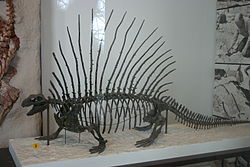- Edaphosaurus
-
Edaphosaurus
Temporal range: Pennsylvanian - Cisuralian, 303–265 Ma
Edaphosaurus boanerges, AMNH Scientific classification 
Kingdom: Animalia Phylum: Chordata Class: Synapsida Family: †Edaphosauridae Genus: †Edaphosaurus
Cope, 1882Species Synonyms - Brachycnemius (Williston, 1911)
- Naosaurus (Cope, 1886)
Edaphosaurus (pronounced /ˌɛdəfɵˈsɔrəs/) is a genus of prehistoric synapsid which lived around 303 to 265 million years ago, during the late Carboniferous to early Permian periods. The name Edaphosaurus means "ground lizard" and is derived from the Greek edaphos/εδαφος ("ground, land") and σαυρος/sauros ("lizard"). This genus was first known from remains discovered in North America, in the late 19th century, and described by American paleontologist Edward Drinker Cope. More recently other fossils attributed to Edaphosaurus have been found in the Czech Republic and Slovakia.
The most characteristic feature of Edaphosaurus is a sail on its back similar to that of other synapsids of the same time, such as the large apex predator Dimetrodon. However, the sail on Edaphosaurus is different in shape and morphology. Along with the reptile-like family Diadectidae, Edaphosaurus is one of the earliest known large plant-eating tetrapods (land-living vertebrates). Early descriptions, referring to its sharp teeth, suggest that the synapsid may have fed on small invertebrates, such as mollusks, although paleontologists now point out that Edaphosaurus also shows herbivore characteristics.
Contents
Description
 Edaphosaurus pogonias (large, background) and Platyhystrix rugosus
Edaphosaurus pogonias (large, background) and Platyhystrix rugosus
The head of Edaphosaurus was short and shallow, and remarkably small compared to its body size. The deep lower jaw had powerful muscles and the frontal teeth were barbed at the cutting edges, helping Edaphosaurus to cut bite-sized pieces from tough terrestrial plants. The palate and inside the lower jaw are covered with small teeth forming a large biting surface.
The sail along the back of Edaphosaurus was supported by hugely elongated neural spines from neck to lumbar region. As compared with the sail of Dimetrodon, the vertebral spines are shorter and heavier and bear numerous small cross bars. Edaphosaurus species measured from 1 m (3 ft) to almost 3.5 m (11 ft) in length and weighed over 300 kilograms (660 lb). This large herbivore had a massive wide body, thick tail and short limbs which show that was a slow moving animal.
In popular culture
- Edaphosaurus is depicted in the 2005 BBC documentary series Walking with Monsters being preyed upon by Dimetrodon. In the animated television series Dink, The Little Dinosaur, a young Edaphosaurus named Shyler is one of the main characters.
See also
- List of synapsids
- Ianthasaurus
- Haptodus
- Sphenacodon
- Platyhystrix - an unrelated animal with a sail on its back
References
- Carroll, R. L. (1988), Vertebrate Paleontology and Evolution, WH Freeman & Co.
- Colbert, E. H., (1969), Evolution of the Vertebrates, John Wiley & Sons Inc (2nd ed.)
- Romer, A. S., (1947, revised ed. 1966) Vertebrate Paleontology, University of Chicago Press, Chicago
- Romer, A. S. and Price, L. I., (1940), Review of the Pelycosauria, Geological Society of American Special Papers, No 28
External links
- Edaphosaurus at palaeos.com.
- Edaphosauridae – edaphosaurs - (list of species)
Categories:- Pelycosaurs
- Carboniferous synapsids
- Permian synapsids
- Prehistoric synapsids of Europe
- Prehistoric synapsids of North America
Wikimedia Foundation. 2010.


